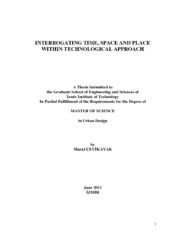Please use this identifier to cite or link to this item:
https://hdl.handle.net/11147/3135Full metadata record
| DC Field | Value | Language |
|---|---|---|
| dc.contributor.advisor | Velibeyoğlu, Koray | - |
| dc.contributor.author | Çevikayak, Murat | - |
| dc.date.accessioned | 2014-07-22T13:50:56Z | - |
| dc.date.available | 2014-07-22T13:50:56Z | - |
| dc.date.issued | 2011 | - |
| dc.identifier.uri | http://hdl.handle.net/11147/3135 | - |
| dc.description | Thesis (Master)--Izmir Institute of Technology, City and Regional Planning, Izmir, 2011 | en_US |
| dc.description | Includes bibliographical references (leaves: 55-57) | en_US |
| dc.description | Text in English; Abstract: Turkish and English | en_US |
| dc.description | vii, 57 leaves | en_US |
| dc.description.abstract | Technology was and is the most powerful tool, humankind used to develop civilizations and improve the quality of their environment and life. Beside this fact, humankind comprehends and creates solutions in their physical surroundings like buildings, vehicles and clothes. This process of creation relies upon certain factors as necessities, search of variation and evolution. As technology evolved when covering necessities and demands, the relationship between physical environment and humankind has changed respectively like bridges or space shuttles. Since information age began with emerging computer technology, this change in relationship has peaked to a different level where physical environment is slightly replaced with virtual interactions through computers and other various devices. Here, in cities where technology has distinctive marks on, this effect can be tracked through citizens " everyday life and from the use of urban spaces. The alternating interaction routine of people from physical environment to space-free virtual space has resulted with lacks in using urban space that are the communication spaces of the city. The aim of this study is to paraphrase the evolution of this transformation from literature and designate potential trails to approach this problem by exploring global practices. | en_US |
| dc.language.iso | en | en_US |
| dc.publisher | Izmir Institute of Technology | en_US |
| dc.rights | info:eu-repo/semantics/openAccess | en_US |
| dc.subject.lcsh | City planning--Technological innovations | en |
| dc.title | Interrogating Time, Space and Place Within Technological Approach | en_US |
| dc.type | Master Thesis | en_US |
| dc.institutionauthor | Çevikayak, Murat | - |
| dc.department | Thesis (Master)--İzmir Institute of Technology, City and Regional Planning | en_US |
| dc.relation.publicationcategory | Tez | en_US |
| dc.identifier.wosquality | N/A | - |
| dc.identifier.scopusquality | N/A | - |
| item.openairecristype | http://purl.org/coar/resource_type/c_18cf | - |
| item.cerifentitytype | Publications | - |
| item.fulltext | With Fulltext | - |
| item.languageiso639-1 | en | - |
| item.grantfulltext | open | - |
| item.openairetype | Master Thesis | - |
| Appears in Collections: | Master Degree / Yüksek Lisans Tezleri Sürdürülebilir Yeşil Kampüs Koleksiyonu / Sustainable Green Campus Collection | |
Files in This Item:
| File | Description | Size | Format | |
|---|---|---|---|---|
| T000944.pdf | MasterThesis | 3.53 MB | Adobe PDF |  View/Open |
CORE Recommender
Page view(s)
266
checked on May 5, 2025
Download(s)
104
checked on May 5, 2025
Google ScholarTM
Check
Items in GCRIS Repository are protected by copyright, with all rights reserved, unless otherwise indicated.